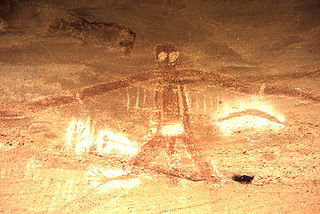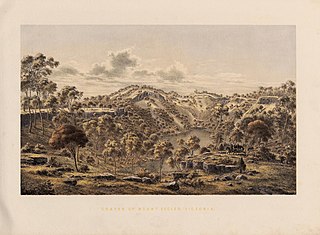Related Research Articles
Native title is the designation given to the common law doctrine of Aboriginal title in Australia, which is the recognition by Australian law that Indigenous Australians have rights and interests to their land that derive from their traditional laws and customs. The concept recognises that in certain cases there was and is a continued beneficial legal interest in land held by Indigenous peoples which survived the acquisition of radical title to the land by the Crown at the time of sovereignty. Native title can co-exist with non-Aboriginal proprietary rights and in some cases different Aboriginal groups can exercise their native title over the same land.

The Aboriginal Land Rights Act 1976 (ALRA) is Australian federal government legislation that provides the basis upon which Aboriginal Australian people in the Northern Territory can claim rights to land based on traditional occupation. It was the first law by any Australian government that legally recognised the Aboriginal system of land ownership, and legislated the concept of inalienable freehold title, as such was a fundamental piece of social reform. Its long title is An Act providing for the granting of Traditional Aboriginal Land in the Northern Territory for the benefit of Aboriginals, and for other purposes.

The Victorian Heritage Register (VHR) lists places deemed to be of cultural heritage significance to the State of Victoria, Australia. It has statutory weight under the Heritage Act 2017. The Minister for Planning is the responsible Minister. Heritage Victoria was established as the State Government listing and permit authority in 1995, replacing the original authority, the Historic Buildings Preservation Council, established in 1974. Listing on the Victorian Heritage Register is separate from listing by a local Council or Shire, known as a Heritage Overlay. Heritage Victoria is currently part of the Department of Environment, Land, Water and Planning of the Government of Victoria, Australia. Heritage Victoria reports to the Heritage Council who approve recommendations to the Register and hear appeals when a registration is disputed. The council also hears appeals by an owner to a permit issued by Heritage Victoria. As of 2021, there are over 2,400 places and objects listed on the VHR.
Framlingham is a rural township located by the Hopkins River in the Western District of Victoria, Australia, about 20 kilometres (12 mi) north-east of the coastal city of Warrnambool. In the 2016 census, the township had a population of 158.

Half-Caste Act was the common name given to Acts of Parliament passed in Victoria and Western Australia in 1886. They became the model for legislation to control Aboriginal people throughout Australia - Queensland's Aboriginals Protection and Restriction of the Sale of Opium Act 1897, NSW/ACT's Aboriginal Protection Act 1909, the Northern Territory Aboriginals Act 1910, South Australia's Aborigines Act 1911, and Tasmania's Cape Barren Island Reserve Act 1912.

An Australian Aboriginal sacred site is a place deemed significant and meaningful by Aboriginal Australians based on their beliefs. It may include any feature in the landscape, and in coastal areas, these may lie underwater. The site's status is derived from an association with some aspect of social and cultural tradition, which is related to ancestral beings, collectively known as Dreamtime, who created both physical and social aspects of the world. The site may have its access restricted based on gender, clan or other Aboriginal grouping, or other factors.

Public Record Office Victoria (PROV) is the government archives of the Australian State of Victoria. PROV was created by the Victorian Public Records Act 1973 with responsibility for the better preservation management and utilisation of the public records of the State. It is an agency of the Department of Government Services.
Australian heritage laws exist at the national (Commonwealth) level, and at each of Australian Capital Territory, New South Wales, Northern Territory, Queensland, South Australia, Tasmania, Victoria, Western Australia state and territory levels. Generally there are separate laws governing Aboriginal cultural heritage and sacred sites, and historical heritage. State laws also allow heritage to be protected through local government regulations, such as planning schemes, as well.
The Aboriginal Cultural Heritage Act 2003 is legislation passed by Queensland Parliament, commencing in April 2004 to recognise, protect and conserve Aboriginal cultural heritage in the State of Queensland
Land councils, also known as Aboriginal land councils, or land and sea councils, are Australian community organisations, generally organised by region, that are commonly formed to represent the Indigenous Australians who occupied their particular region before the arrival of European settlers. They have historically advocated for recognition of traditional land rights, and also for the rights of Indigenous people in other areas such as equal wages and adequate housing. Land councils are self-supporting, and not funded by state or federal taxes.

The Wurundjeri Woi Wurrung Cultural Heritage Aboriginal Corporation, previously the Wurundjeri Tribe Land and Compensation Cultural Heritage Council, is a Registered Aboriginal Party representing the Wurundjeri people, an Aboriginal Australian people of Victoria.

The Aboriginal and Torres Strait Islander Heritage Protection Act 1984(Cth), is an Act passed by the Parliament of the Commonwealth of Australia to enable the Commonwealth Government to intervene and, where necessary, preserve and protect areas and objects of particular significance to Australia's Aboriginal or Torres Strait Islander peoples from being desecrated or injured.
Commonwealth, State, and Territory Parliaments of Australia have passed Aboriginal land rights legislation.
The Victorian Aboriginal Heritage Register (VAHR), is a list of all known Aboriginal cultural heritage places in Victoria, Australia. It was established by and is regulated under the Aboriginal Heritage Act 2006. The Register is administered by the Office of Aboriginal Affairs Victoria, in some instances through delegation to Registered Aboriginal Parties.

A Registered Aboriginal Party (RAP) is a recognised representative body of an Aboriginal Australian people per the Aboriginal Heritage Act 2006 (Vic.), whose function is to protect and manage the Aboriginal cultural heritage in the state of Victoria in Australia.
The Bunurong Land Council Aboriginal Corporation is a Registered Aboriginal Party and incorporated association representing the Bunurong community in the state of Victoria, Australia, particularly in matters relating to the Victorian Aboriginal Heritage Act 2006.
The 2019 Victorian First Peoples' Assembly election was held between 16 September to 20 October 2019 to elect 21 members to the First Peoples' Assembly in the Australian state of Victoria. The election filled seats to the body, which was charged with the responsibility of preparing for negotiations with the Victorian Government about a treaty with the state's Aboriginal population.

Budj Bim heritage areas includes several protected areas in Victoria, Australia, the largest two being Budj Bim National Heritage Landscape and the Budj Bim Cultural Landscape. Within the latter, there are three Indigenous Protected Areas: the Tyrendarra Indigenous Protected Area, Kurtonitj Indigenous Protected Area, and the Lake Condah Indigenous Protected Area.
The Aboriginal Heritage Act 1972 (AHA) is a law in the state of Western Australia governing the protection of Aboriginal cultural sites, which was superseded by the Aboriginal Cultural Heritage Act 2021 on 1 July 2023.
References
- ↑ "Review of the Corporations (Aboriginal and Torres Strait Islander) Act 2006". Victorian Aboriginal Heritage Council. Retrieved 6 January 2021.
- ↑ "Registered Aboriginal Parties". State of Victoria, Department of Premier and Cabinet. Archived from the original on 7 December 2013. Retrieved 10 December 2013.
- ↑ "Aboriginal Heritage Act 2006: Purpose". Australasian Legal Information Institute. Retrieved 10 December 2013.
- 1 2 "Aboriginal heritage legislation". Aboriginal Victoria. 18 December 2019. Retrieved 10 March 2020.
- ↑ "Authorised Version No. 023, Aboriginal Heritage Act 2006: No. 16 of 2006" (PDF). Retrieved 10 March 2020.
Authorised Version incorporating amendments as at 1 January 2020
- ↑ "Aboriginal Heritage Act 2006: Objectives". Australasian Legal Information Institute. Retrieved 10 December 2013.